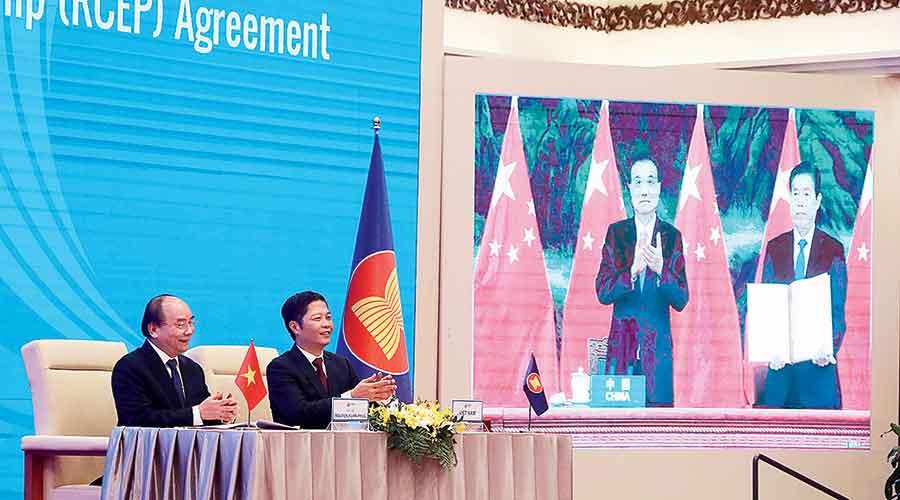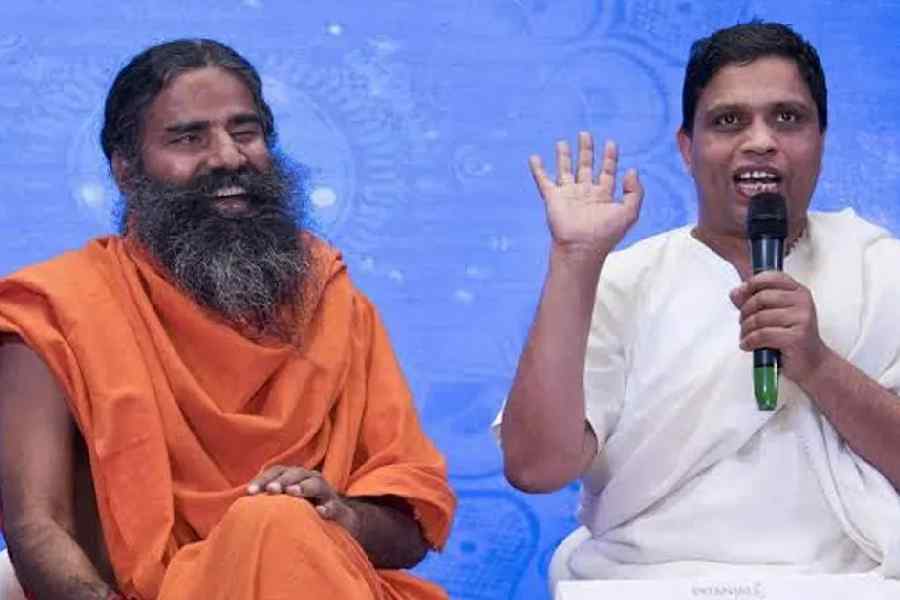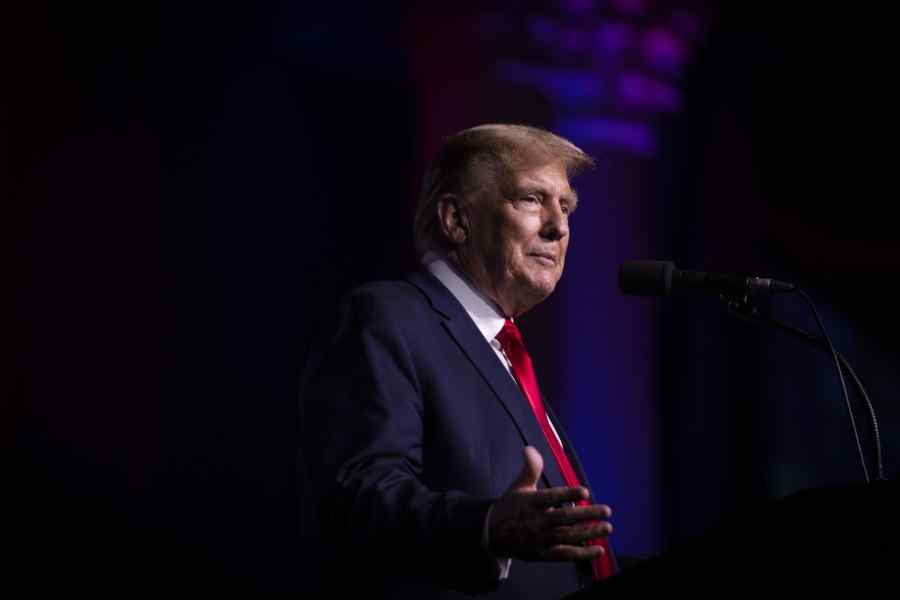It was Asia’s big party but India stayed away. It was only a virtual bash but all the big names were there – Japan, China, South Korea and Australia and the like. And what was the occasion? Well, last Sunday, 15 nations with a combined population of 2.2 billion, signed into being the world’s largest trading bloc, the Regional Comprehensive Economic Partnership (RCEP). The emergence of this new free-trade pact flags the key question of whether India was right to walk away from the trade bloc, literally at the 11th hour.
The bloc binds the regional powerhouse China with advanced economies like Japan, South Korea, Australia, New Zealand and Singapore plus a handful of countries with a distinctly poorer, Third World flavour like Cambodia, Laos and the Philippines. China, the aspiring superpower, is the moving force behind RCEP and the bloc’s other countries are already watching nervously, worried about being bullied by it.
India shocked everyone last year when it suddenly declared it wouldn’t join RCEP as it was unhappy with the terms offered. Among India’s demands were more protection from cheap Chinese goods that might flood our country, a better deal for service-sector industries (where we have greater muscle) and freer movement for professionals.
Certainly, everyone wanted us to join. The Chinese were hoping to get easier access for its products to India’s 1.4-billion strong market. The other countries, especially Japan, Australia and New Zealand wanted us as a counterweight to the Chinese mega-giant that threatens to totally dominate RCEP. In fact, members are so keen to bring India into the fold that a special fast-track procedure has been outlined in the agreement should we wish to sign up.
Despite all that, it doesn’t look likely that we will join RCEP anytime in the near future. Apart from the scores of Indian industries that were terrified about facing a gigantic wave of competition, there was political opposition from the RSS which still espouses an ultra-nationalistic philosophy that wants to block as many imports as possible. Also, the military standoff in Ladakh makes it even more unlikely that India would sign a trade deal in which China was the largest and most muscular player. Keeping the Chinese out is one of the unspoken aims of India’s atmanirbhar programme.
The government defends its position by arguing that it prefers bilateral free trade agreements with individual countries and trade groupings – but it says even these haven’t brought huge benefits. We have trade agreements with Asean and with individual countries like Malaysia and Indonesia and we have a mammoth $48-billion trade deficit with China.
Foreign Minister S. Jaishankar said Monday that the effect of some trade agreements had “been to de-industrialise some sectors.” India had allowed other countries “unfair” trade and manufacturing advantages “in the name of openness” and a globalised economy, Jaishankar said. Former Congress finance minister P. Chidambaram said Jaishankar was turning back the clock. He’s “speaking in the language and in the words that I heard in the 1970s and 1980s,” Chidamabaram said.
India could end up being the long-term loser if it turns its face against ever joining the trade grouping. Many global corporations are now moving out of China and looking for new production bases. It would make sense for many to put up factories in an RCEP country and be part of the grouping’s global supply chain so their products could move smoothly tariff-free to other countries. Look at Vietnam, for instance, which is part of RCEP and also has a free trade agreement with the European Union (it also has one with India).
Also, modern trans-national corporations have streamlined production and reduced costs by creating multi-country value chains (China, for instance, produces 80 per cent of the world’s ballpoint pens but imports the pen tips from Japan, Germany and Switzerland). Says Santosh Pai, Link Legal Law Services: “India needs to be part of global value chains. Domestic consumption alone is not enough to attract foreign direct investment (FDI). And if we want to attract export-oriented FDI, then such free trade agreements are essential.”
Were Indian companies right to oppose joining RCEP? India’s giant and politically powerful dairy industry is worried, for instance, that it might lose out to skimmed milk imports from New Zealand. In a bid to win over India, the New Zealand agriculture and food safety minister visited the Amul plant in Anand. The New Zealanders were even willing to agree to tariffs and quotas on skimmed milk imports.
Then, India’s pharmaceutical sector, one of our few globally recognised industries, also protested about joining RCEP because the agreement wanted Indian companies to accept tougher patent rules. In the medium-scale sector, many companies feared they would be steamrollered out of existence by cheap Chinese products.
“We cannot join because we are not competitive. And we are not competitive because policy limits us and folks are risk averse,” says Manoj Kewalramani, a China Studies fellow at Takshashila Institution.
Turning our face against competition, though, cannot be a long-term solution, experts say. “The political economy is such that you cannot enact changes. Then how does one ever get competitive? RCEP could have created a shock to the system, an impetus to change,” says Kewalramani. Also, there are other possible consequences of staying out of RCEP. For India, a particular worry is that China will be able to create standards for products and impose them in the RCEP region, leaving us in the cold.
Looking beyond trade and the economy, the other Asean countries, Australia and Japan want India as a check on China. There are a rising number of conflict flashpoints across Asia – and almost all involve the Chinese and the region would like India to serve as a counterweight. For instance, Japan and China are tussling over the Senkaku Islands, a group of uninhabited islets and rocks.
Though Japan has extensive business links with China, the two countries do not have a trade agreement– and that’s despite the fact that around 35,000 Japanese companies have plants in China. That compares with only 1,500 firms in India. (Incidentally, Japan and Australia on Tuesday signed a military pact allowing reciprocal visits for training and operations. Japan has only one other military pact with the US signed in 1960 allowing foreign troops on its soil).
Similarly, China has disputes with most of the countries in the South China Sea over its Nine Dash Line. Chinese belligerence is one reason why the Quad grouping of India, the US, Japan and Australia are currently holding exercises in the Arabian Sea. The Quad held exercises in the Bay of Bengal in early November.
For the time being, it looks like India won’t take part in RCEP or any other agreement like it as it says it won’t join any group that has China as a member. But then we need to fashion an alternate strategy to boost exports. Says Pai: “Not joining is not the end of the world but the key question is whether India is conscious of the need to make up for not joining RCEP.”










